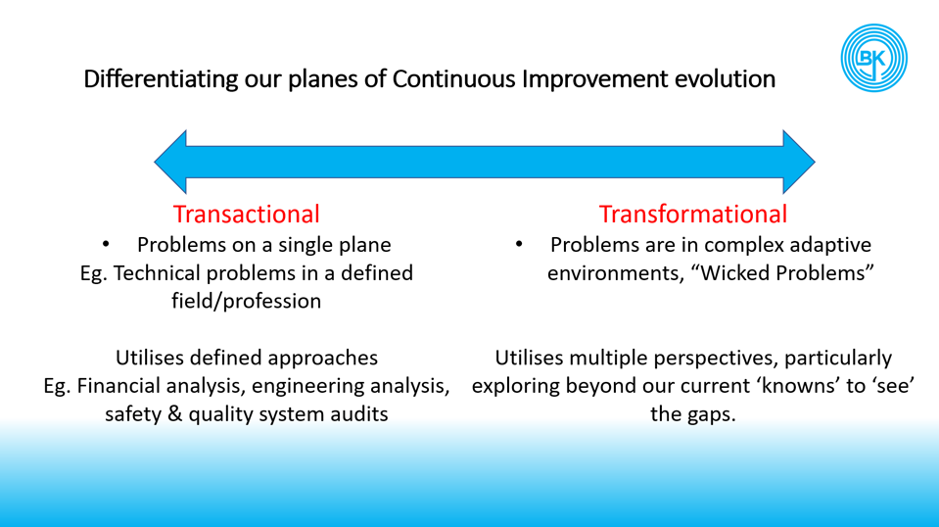Being Clear on the Scope of our Continuous Improvement Evolution
Talking with leaders who are experienced Continuous Improvement practitioners, we have been finding it a useful clarifier to the discussion for our own leadership scope clarity and for the teams receiving the message to be more specific about the range of improvement work from transactional through to transformational. Different topics and different scoping.
For the sceptical ‘transformation’ can just sound like a buzz word for Consultants or ambitious Executives keen to leave a mark. Perhaps sometimes it is. I know sometimes I think that too.
However, there is a definitional distinction which when used appropriately can add clarity to all involved.
Why is having all parties clearly seeing this range of scopes so critical?
CLARITY and ALIGNMENT are a mantra for leaders of strategy execution. We are aware it is leadership accountability that the mission objectives clear, the roles, the plans, the timelines etc are all clear. The clarifying is iterative as we engage stakeholders and ensure we are “all on the same page”.
It has been a fascination to me over the years how even when we speak the same language and are saying the same words we may not actually be saying the same thing.
There are many definitional points that are worthy of unpacking for clarity and alignment between a Board, Executive, and the organisational teams.
Being clear on the scope of the Continuous Improvement evolution is a fundamental recurring theme which is all the more important in these times of accelerated and turbulent change.
I knew a Chief Operating Officer (COO), let’s call them Peter, who worked for a CEO and Board using the transformation word in all their strategic documents and discussions. Peter was responsible for the planning and implementation and accountable for the delivery of targeted outcomes. Peter was an experienced leader and respected as a champion of continuous improvement and a practitioner of many robust improvement methods. He had a strong track record of taking out operational costs.
Peter launched into the program with gusto setting up a Project Management Office (PMO), declaring milestones and forming a team of proven financial and operational technical expertise.
As the work progressed Peter began to feel the heat coming in from the CEO, other colleagues, and rumblings from people that he felt had no idea about the operations at all.
He knew operations was not a place for the feint hearted so buckled down and added even more rigour to PMO.
As results began to come in, instead of a celebration of the milestones the CEO and Board were becoming more agitated and meetings increasing in tension. Peter, a proud high performer, was in a world of pain and described this phase of his work as being in a dark fog. At a Board meeting led by an external facilitator it started to become clear to Peter that not only were the issues substantive with the program of work, that the issues went back to the original scoping.
There were so many factors not considered in the scoping he had led. So many stakeholder perspectives not considered engaged. The skills he had engaged were narrow and as per his direction, the people stuck to their defined expertise.
Opening up the definitional distinctions between transactional level improvement programs and transformational level improvement programs was an epiphany for Peter and almost immediately shifted the dynamic between him and his CEO.
Peter later found that his Board had been well progressed in discussions to terminate him. Instead, he was able to regroup on the program going back through scope clarity and the broader stakeholder engagement that entailed. The strategy recovered from a misfire to making solid progress.
When scoping your work do you articulate the plane of improvement expected?
Bernie
